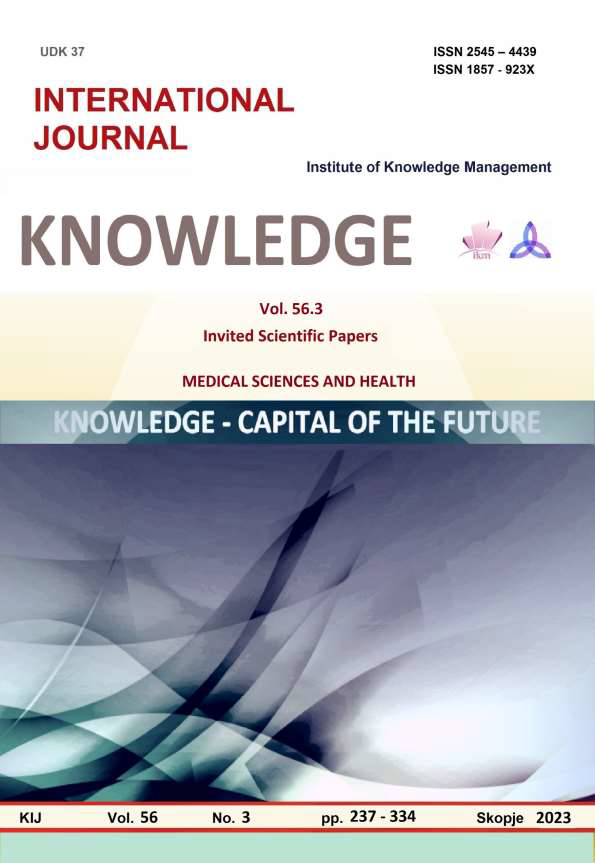CORRELATION BETWEEN THE IMMUNE SYSTEM AND THE OXIDATIVE STRESS IN SPORTISTS
Keywords:
oxidative stress, free radicals, antioxidants, physical activityAbstract
An imbalance between production of oxygen reactive species and antioxidants is defined as oxidative
stress. As a result we have cell and tissue damage. Several authors pointed out that oxidative stress could be
responsible for several pathological conditions, such as cancer, diabetes and heart disease.It is also involved in the
aging process. It is true that the body's cells produce free radicals during normal metabolic processes and intense
physical activity causes oxidative stress. Free radicals produced during exercise are important modulators of muscle
and systemic adaptation. Here we will discuss the correlation between prolonged exercise and increased production
of oxidants in skeletal muscles, i.e. superoxide dismutase, glutathione peroxidase and catalase. It has been also
observed, that reactive oxygen species stimulate the mitochondrial biogenesis cascade in response to endurance
training, ie. chronic muscle contractions. We can reach the conclusion that exercise causes oxidative stress by
increasing the amount of free radicals and decreasing the level of antioxidant enzymes in many tissues and organs.
Summarizing, we can affirm that different intensities and forms of exercise result in different amounts of reactive
oxygen tosues production. It is true that exercise-induced reactive antigen species can be very useful in stimulating
signaling pathways for antioxidant enzyme activity (SOD, GPx and CAT), mitochondrial biogenesis (PGC-1α
expression) and glucose metabolism and absorption (insulin sensitivity , GLUT4 expression).
References
Davalli, P., Mitic, T., Caporali, A., Lauriola, A., Arca, D., & Arca, D. (2016). ROS, Cell Senescence, and Novel Molecular Mechanisms in Aging and Age-Related Diseases. Oxidative Medicine and Cellular Longevity, 1–18
D'Angelo, S., Lembo, S., Flora, F., De Bonis, M.L., Balato, A., Ayala, F., Balato, N., Galletti, P., & Zappia, V.(2012)a. Abnormal isoaspartyl residues in erythrocyte membranes from psoriatic patients.Archives of DermatologicalResearch, 304(6), 475-479.
D’Angelo, S., Trojsi, F., Salvatore, A., Daniele, L., Raimo, M., Galletti, P., & Monsurrò, M.R. (2013). Accumulation of altered aspartyl residues in erythrocyte membrane proteins from patients with sporadic amyotrophic lateral sclerosis. Neurochemistry International, 63 (6), 626-34.
D'Angelo, S., Martino, E., Ilisso, C.P., Bagarolo, M.L., Porcelli, M. & Cacciapuoti, G. (2017). Pro-oxidant and pro-apoptotic activity of polyphenol extract from Annurca apple and its underlying mechanisms in human breast cancer cells. International Journal of Oncology, 51, 939-948
Galletti, P., De Bonis, M.L., Sorrentino, A., Raimo, M., D'Angelo, S., Scala, I., Andria, G., D'Aniello, A.,Ingrosso, D., & Zappia V. (2007). Accumulation of altered aspartyl residues in erythrocyte proteins from patients with Down's syndrome. FEBS Journal, 274(20), 5263-5277.
Gutteridge, J.M., & Halliwell, B. (2000). Free radicals and antioxidants in the year 2000. A historical look to the future. Annals of the New York Academy of Sciences. 899, 136–147
Ingrosso, D., D'Angelo, S., di Carlo, E., Perna, A.F., Zappia, V., & Galletti, P. (2000). Increased methyl esterification of altered aspartyl residues in erythrocyte membrane proteins in response to oxidative stress. European Journal of Biochemistry, 267, 1-10.
Malaguti, M., Angeloni, C., & Hrelia, S. (2013). Polyphenols in exercise performance and prevention of exercise-induced muscle damage. Oxidative Medicine and Cellular Longevity, 2013, 825928.
Mankowski, R.T., Anton, S.D., Buford, T.W., & Leeuwenburgh C. (2015). Dietary Antioxidants as Modifiers of Physiologic Adaptations to Exercise. Med Sci Sports Exerc. 47(9), 1857–1868.
Motti, M.L., D’Angelo, S., & Rosaria, M. (2018). MicroRNAs, Cancer and Diet: Facts and New Exciting Perspectives. Current Molecular Pharmacology, 11, 90-96.
Muñoz Marín, D., Barrientos, G., Alves, J., Grijota, F.J., Robles, M.C,. & Maynar, M. (2018). Oxidative stress, lipid peroxidation indexes and antioxidant vitamins in long and middle distance athletes during a sport season. The Journal of Sports Medicine and Physical Fitness, 58(12), 1713-1719.
Radak, Z., Zhao, Z., Koltai, E., Ohno, H., & Atalay M. (2013). Oxygen consumption and usage during physical exercise: the balance between oxidative stress and ROS-dependent adaptive signaling. Antioxid ,Redox Signal, 18(10), 1208–1246.
Webb, R., Hughes, M.G., Thomas, A.W., & Morris, K. (2017). The ability of exercise-associated oxidative stress to trigger redox-sensitive signaling responses. Antioxidants (Basel). 6(3).





